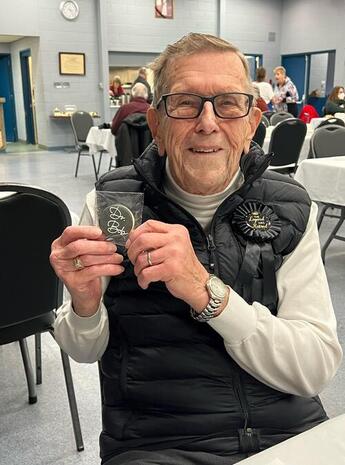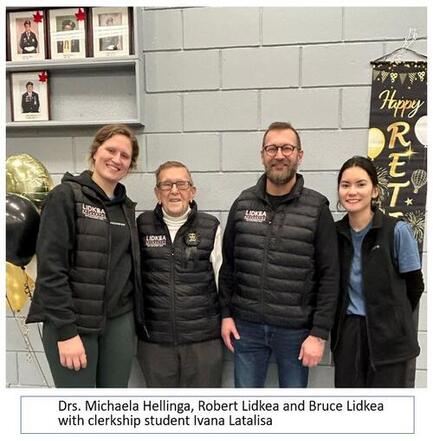Dr. Robert Lidkea has been first in a lot of areas, starting when he forced a tuxedo-clad doctor to leave a New Year’s party to deliver him in North Bay. He was the hospital’s first baby of 1931.
Recently, however, he gave up on being last – the oldest practicing optometrist in Ontario. He turned 93 the day he retired from his practice in Fort Frances, Ontario.
“I enjoyed coming to work. I enjoyed being with people and helping them see better and more comfortably,” says Robert about why he kept working for so long, even returning after an attempt at retiring three years ago. “I needed something to do. And I needed to keep my son in line,” he adds with a grin.
His son, Dr. Bruce Lidkea, 56, who has been the Lidkea Optometry owner for the last couple of decades, laughs too.
“I may have signed his cheques, but I was never his boss, that’s for sure.”
Robert was a high school student when his hometown optometrist suggested he might want to take over the practice one day. So in 1949, Robert headed to Toronto for optometry school. He graduated from the College of Optometry of Ontario, the University of Waterloo School of Optometry and Vision Science’s direct forerunner, in 1952.
 Training was only three years at the time and there were no board exams, so at 21, as soon as he graduated with a gold medal, Robert became Ontario’s youngest practicing optometrist.
Training was only three years at the time and there were no board exams, so at 21, as soon as he graduated with a gold medal, Robert became Ontario’s youngest practicing optometrist.
Unfortunately, his North Bay optometrist had suffered a couple of heart attacks and had already found someone else to take over the practice, so that plan was scuttled. Then Robert saw an ad looking for an optometrist at a medical clinic in Fort Frances, a small northern Ontario town he’d never even heard of.
“At the time, lots of optometrists worked in jewelry stores, but here was a chance to work in a clinic setting,” says Robert. “The optometrist was female, which was rare back then, and she had young children at home, so she wanted to retire.”
Bruce takes up the tale: “As soon as my dad graduated, he took the train up here, walked in the door and introduced himself. She handed him the keys, said ‘good luck,’ and walked out.”
At first, the young Robert felt underprepared. The equipment onsite was outdated even by 1952 standards – he and Bruce later donated some of it to the School’s Museum of Vision Science. And he’d only seen 15 to 20 patients before he graduated.
“Looking back, it was very primitive training,” Robert says. “We didn’t have the equipment to do much. We weren’t allowed to use diagnostic drugs. Even slit lamps were rare. Today we have students come to our office for their externals and I’m amazed at how much they know.”
Fortunately, Robert liked to learn. Having graduated as a RO – a registered optometrist – he took correspondence courses when they became available and wrote exams to obtain a Doctor of Optometry from the College in 1957.
Robert also did plenty of professional development, sometimes in exotic locales such as Hawaii, other times closer to home.
“I’ve been in school for 89 years,” says Robert. “You have to keep learning. That’s what life is all about.”
In the 1970s, he became the first optometrist in Ontario to fit soft contact lenses because he went for training in Winnipeg, about four hours from Fort Frances, before training was available in Ontario. The soft contacts back then were thick and rubbery. Patients had to make their own saline solution and put them in a cooker at night to sterilize them.
Always fond of the latest tech, Robert bought one of the first retinal cameras in the 1970s – it was a Polaroid.
“You had to wave it back and forth until it dried but it worked well,” remembers Robert.
The clinic has changed a lot over the years. The physicians moved out long ago, so for a while, Robert rented out some of the space to various businesses. When Bruce started practicing in 1994 after graduating from optometry school in Indiana (he got his Bachelor of Science from the University of Waterloo), Lidkea Optometry took over more of the space. Now it takes up the whole building. It recently went through a major renovation, so both the space and the equipment are fully modernized.
 Though Fort Frances has a population of less than 8,000, it serves as a hub for a dozen or so communities in the area. With some of the Indigenous communities being quite remote, regular access to eye care is still a problem, so Lidkea Optometry sees more ocular disease than most urban practices do. The local hospital also refers patients for procedures such as removing foreign objects from the eye.
Though Fort Frances has a population of less than 8,000, it serves as a hub for a dozen or so communities in the area. With some of the Indigenous communities being quite remote, regular access to eye care is still a problem, so Lidkea Optometry sees more ocular disease than most urban practices do. The local hospital also refers patients for procedures such as removing foreign objects from the eye.
All this makes Lidkea Optometry a good training ground for students. Bruce has been supervising fourth-year Waterloo clerkship students for some 20 years.
In fact, with Robert’s impending retirement, an opportunity came up for one of those former students. Dr. Michaela Hellinga (OD ’23) became an associate at Lidkea Optometry shortly after she graduated.
Robert is glad to be passing the torch to the new generation, but he’s not going far. He has no ambitions to travel, content to spend time in a community he loves and which he has long given back to as an enthusiastic volunteer. Besides, he likes to keep an eye on the clinic. Says Bruce:
“He still shows up pretty much every morning, checks the office mail and makes sure I’m not goofing off.”






